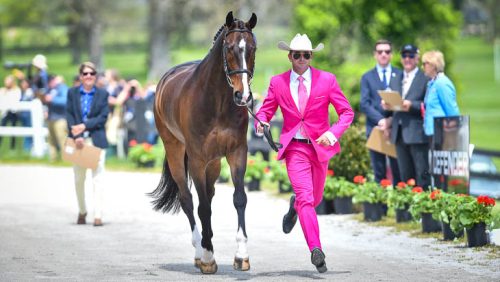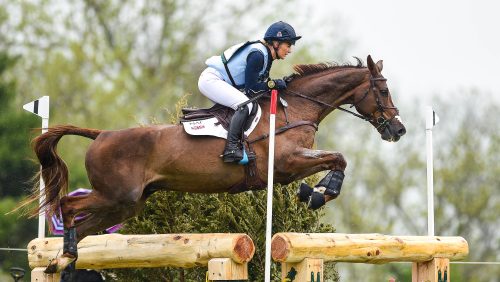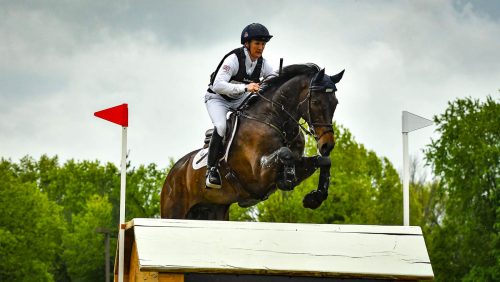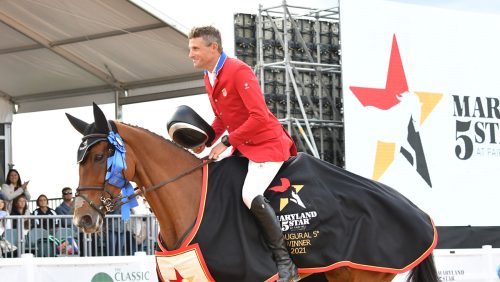The worst spring flooding on record couldn’t stop the Groton House Farm Horse Trials II, June 23-25 in Hamilton, Mass., and the conditions couldn’t deter Phillip Dutton from winning, either.
Dutton, West Grove, Pa., dominated the advanced/ intermediate division, winning the Amanda Cup trophy on Tru Luck and placing third on his World Equestrian Games hopeful, Connaught. He also won a division of open preliminary on his wife Evie’s 7-year-old, Australian gelding, Loose ‘N Cool.
After placing second in dressage, Dutton and Tru Luck became the only intermediate pair to complete a faultless cross-country round, which boosted them into the lead.
“The ground jury did a good job in slowing the speeds so you had no temptation to go too fast in the deep areas,” Dutton remarked. “The footing held up quite well at the jumps themselves.
“I really didn’t push ‘Milo’ [Tru Luck] for the time,” Dutton explained. “He’s just got a great gallop.”
One of Dutton’s students, Amy Smith, owned Milo, a 9-year-old bay gelding, and competed him to the two-star level. Although a trio of owners bought the horse for Dutton last fall, minor pasture injuries kept Milo out of action until this spring. Dutton, nevertheless, debuted the horse at advanced level, placing second at Plantation Field (Pa.) and MCTA (Md.), then went on to finish third in the Jersey Fresh CCI** (N.J.) in early June.
Despite the horse’s success, Dutton appreciated the opportunity to give the horse an easier intermediate-level experience at Groton House. “[Milo] has three good phases and he’s quite an exciting horse to develop, but he’s still a bit green,” Dutton explained. “I felt him question the sunken road [on cross-country] here, so he just needs to get to know his job, and get to know me, a little better. This was a nice course to run him over this time of year.”
Because of changes in the spring and summer eventing schedule, organizer Ann Getchell decided to tone down the intermediate cross-country test this year. When torrential rains hit (see sidebar), the ground jury slowed the cross-country speed from 550 to 500 meters per minute and removed one of the more difficult combinations on the course, the downhill glade followed off a sharp turn by an up-bank and ditch (11 and 12AB).
Although five competitors chose not to run cross-country in the wet conditions–among them Bonnie Moser and Jenga, short-listed for the upcoming WEG in Aachen, Germany–only one of the 14 horses who did complete posted a refusal on the scoreboard. Time faults were plentiful for everyone except Dutton and Tru Luck.
The Groton House track also proved to be a confidence-builder for another well-known pair, Darren Chiacchia and Windfall II, who beat Dutton in dressage but dropped down to second after collecting 2.8 cross-country time faults.
“He was my old horse out there today,” said a delighted Chiacchia. “I felt it the minute I got in the start box; I knew I had my game horse back.”
Windfall and Chiacchia retired from the course at the Rolex CCI**** in April, and then had problems again at the Jersey Fresh CCI*** (N.J.) in May.
When drenched ground necessitated moving show jumping to a rectangular sand warm-up arena, course designer Susie Banta was determined not to give riders a conventional, down the long side or across the diagonal jumping test. She opted instead for numerous bending lines and rollback turns, creating a course that only four of the 14 remaining riders in the division managed to jump faultlessly. Dutton and Bruce Duchossois’ 13-year-old gelding Connaught posted one of the few clear rounds, moving them up from fourth to finish third.
Just .3 points separated Windfall and Tru Luck going into Sunday’s jumping, but they remained first and second when each horse dropped one rail.
Dutton blamed himself for the horse’s error. “I didn’t quite get him forward enough in the warm-up,” he explained.
He plans to give Milo another intermediate run at the upcoming Stuart (N.Y.) horse trials before returning to advanced level with a goal of competing at the Fair Hill CCI*** (Md.) in October.
ADVERTISEMENT
Windfall’s second-placed finish is one step in what Chiacchia calls his “summer rebuilding plan” for the horse.
“Obviously, I’m devastated–I never thought I’d see the day when Windfall would be sitting out the WEG squad,” Chiacchia said. “But I just didn’t have enough time to put it all back together between Rolex and New Jersey. You bet this wasn’t my plan A, but with hard work and a careful program, we’ll have our eye on the FEI World Cup.”
New Partner For Chiacchia
Chiacchia also used the Groton House intermediate track to bolster a new partnership with Theodore Iorio’s 13-year-old Swedish warmblood-Thoroughbred gelding, Better I Do It. The horse won the same division last year here as well with his previous rider, Adrienne Iorio.
Chiacchia took over the ride in May and placed second in an intermediate section at the Virginia Horse Trials later that month. “The horse steps up a notch each time I compete him,” said Chiacchia.
Chiacchia guided Better I Do It through a test not only good enough for the lead but, at 24.6, the lowest dressage score of the entire competition. “His flatwork is really coming together,” Chiacchia said. “Every time we work on something, he comes out the next day thinking about that.”
Although nine intermediate competitors withdrew before cross-country, leaving only eight horses to start, Chiachia’s win remained convincing since Better I Do It jumped faultlessly, adding only time faults to the scoreboard.
“He’s a careful horse, and he wants an accurate ride,” Chiacchia said. “I took a few time faults because I need to connect with him and prepare a little bit early for his cross-country fences. The course gave him just enough to do out there.”
But it was the horse’s clear show jumping, which allowed him to win with two rails in hand, that delighted Chiacchia the most. “He used to take a little bit of a bid to the jumps, so I’ve been working on making him wait, and he couldn’t have been more attentive today,” he said.
A Popular Preliminary Winner
The hometown crowd cheered for Beth Murphy-Keane and her 6-year-old, Dutch Warmblood mare, Tantibes, as they claimed victory in a division of open preliminary. The professional trainer from West Boxford, Mass., is the daughter long-time horse trials director, George Murphy.
Murphy-Keane and Tantibes finished 12th after dressage, then vaulted into the lead by finishing cross-country without time or jumping faults, one of only two riders among all three preliminary sections to do so. A double-clear show jumping round allowed them to finish on their dressage score and win the division.
Murphy-Keane bought the mare in Florida last winter and moved her from novice to preliminary in just one season. The pair won their first preliminary-level outing at UNH Horse Trials (N.H.) in May.
“I’m pretty psyched she’s doing what she’s doing,” said Murphy-Keane. “She’s the first warmblood I ever owned, and she came along slowly at first, until everything began to fall into place. It’s been a long road to get her broke on the flat. The dressage atmosphere here was very electric for her, and I’m glad she kept it together in her test.”
By comparison Murphy-Keane felt that making the cross-country time was easy for her horse. “She naturally loves to run and jump and she’s so careful that you don’t have to set her up,” Murphy-Keane explained. “She doesn’t mind the mud at all so I just let her go on out there and pick her pace.”
The mare’s clear show jumping round proved more challenging, however. “She was leaping around the warm-up,” Murphy-Keane said. “She had a little bit of run left over from cross-country in her brain. I’ve never had her be hot in the show jumping before, so I just trotted in there and tried to ride forward and not get in her face.”
Young rider open preliminary winner, Cora Katz-Samuels, 18, from Stanfordville, N.Y., and her 13-year-old, American Warmblood mare Bella were the only other preliminary-level pair to finish on their dressage score.
“She needs a very positive ride on cross-country but if you’re there for her, if you believe she can do it, she’ll jump everything,” said Katz-Samuels, who will attend Hamilton College (N.Y.) this fall.
ADVERTISEMENT
After finishing ninth in dressage, Katz-Samuels looked in amazement at the scoreboard to find they had moved into the lead after cross-country. “I just went around and tried to pretend the mud wasn’t there and kept her in the rhythm,” she said.
Holding the overnight lead placed an unfamiliar pressure on Katz-Samuels going into show jumping. “But as I went into that arena, I thought, we’re doing this, we’re going clean,” she explained. “I just thought about keeping her rhythm through the turns and not letting her get on her forehand between the jumps.”
Katz-Samuels has owned the mare for three years, but school obligations prevent her from competing regularly; Groton House marked only her third preliminary start. Ever since watching her mother ride around the preliminary-level course here a few years ago, Katz-Samuels has wanted to compete here. “I just wanted to do preliminary at Groton House, I didn’t think about winning here,” she said.
The Show Must Go On
By 8 p.m. on show jumping night at the Groton House Farm Horse Trials II, the Boston Globe reported that 22.26 inches of rain had fallen in Boston during May and June–the most in a two-month period since 1872, when records started being kept.
Rainfall totals in Hamilton’s Essex country were even higher in the preceding weeks, and the region had already been declared a federal disaster area. The extreme conditions forced organizer Ann Getchell to cancel Groton House I, the popular lower-level horse trial that attracts 300-plus entries and runs the previous weekend. Luckily, the stalwart Groton House grounds crew was able to go to work as sunshine returned in the days before the second event.
Parking venues were moved, new traffic patterns were established, and impassable areas were roped off throughout the family farm. Getchell rerouted the cross-country track to avoid areas that couldn’t possibly dry in time, while the crew added gravel footing to the take-off and landing areas surrounding all the fences. Culverts were established, drainage ditches were dug, and pumps worked overtime, everywhere on the property.
Signs peppered the grounds with dire warnings of places to be avoided–“quagmire,” “morass,” “quicksand,” “glug” among them. “We tried to come up with every word for ‘swamp’ that we could possibly imagine,” Getchell quipped.
“The entire crew was so fantastic, trying to get the grounds ready for the second weekend,” Getchell said. “Everyone really rose to the occasion.”
Although clear skies held for a few hours on dressage day, the rains returned by Friday afternoon and never let up throughout the weekend.
Technical delegate Helmut Boehme and ground jury co-presidents Jane Hamlin and Jack Leary made swift decisions on cross-country morning, lowering speeds for all three levels and removing one preliminary and two intermediate jumps, both involving hillside landings, from the course.
The trio spent the entire day monitoring the course on a roving tractor, accompanied by the ever-present grounds crew who repaired footing wherever it was required. “We made the decision to keep going one division at a time,” said Hamlin.
“I have to say I’m proud of the competitors, who rode wisely under the conditions. No one should feel like a failure for having had time faults this time,” Hamlin said.
No amount of heroics, however, could render the sodden show jumping field useable by Sunday. So the officials suggested moving the location to a sand warm-up arena near the cross-country start. Show jumping courses were redesigned to fit the new venue, jumps were uprooted and reassembled, and the patrons’ tent was moved–all in the space of a few hours.
“At this point, I just couldn’t ask my volunteers for one more thing,” said Getchell. “But they just said, ‘Let’s do it’. They just stepped up to the plate.”
“This was a unique situation really, where the competitors, the officials, and the grounds crew all worked together to keep the event going,” said Boehme. “It was a tremendous cooperative effort, something everyone associated with this event should be proud of.”














